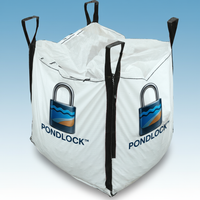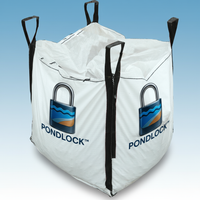Benseal Sodium Bentonite Clay for sealing marginal pond soils. Sold in full pallet of 48 - 50lb bags, 2,400lbs total.
One 50lb bag = 0.7 cubic feet Bentonite is a natural expanding clay sealant that when exposed to moisture can expand 15X or more creating a very effective pond sealant when applied correctly.Bentonite Clay Application Rates for pond/lake bottoms
To properly apply bentonite to seal a pond, the pond must be drained and the bentonite clay then incorporated into the soil of the pond bottom and sides. The application rate for bentonite ranges from 2 pounds to more than 5 pounds per square foot depending on the soil characteristics. For clayey and silty soils, 2 pounds per square foot MAY be sufficient. For sandy soils 4 pounds MAY be sufficient and for soil containing gravel and rock, in excess of 5 pounds will be required to obtain a seal. Once the bentonite is applied, the soil should be disk harrowed to mix the soil and bentonite and then compacted.
Alternatively, a continuous blanket of bentonite clay can be applied to the soil and then carefully covered with clean soil or sand to prevent the clay from mobilizing into the water column. Placing the bentonite in a confined layer is far more effective as it forces the clay into adjacent soil pores creating a more effective seal.
For best results, test application rates with your soils by treating a small area at the anticipated bentonite clay application rate. Drive a 12" or larger diameter smooth wall pipe at least 8" into the soil column. Manually compact the soil within the pipe and fill with 18" or more of water. Measure the rate of decline in the pipe and adjust application rate for your soils as needed. 45 lb pails of sodium bentonite are available for testing application rates or treating small areas.
Pond or Lake Dam Repair
For a leaking embankment, if the location of the leak has been identified, it may be possible to construct a core trench in the embankment to slow the leak. To install a core trench, excavate a minimum 12 inch wide trench to at least 3 feet below the pond bottom elevation. The trench should be located as far back from the pond edge as possible while still remaining on the flat top of the embankment.
The goal is to create an impervious core in the embankment which will not allow water to pass through. This impervious core can be created in a number of ways. Bentonite can be mixed with the excavated soil at a rate of 30% bentonite and 70% native soil. The material should be placed back inthe trench and compacted with a trench roller, plate tamper, or excavator bucket in 6 inch lifts.
Free Standard Freight to lower 48 states. Lift gate service is additional.











